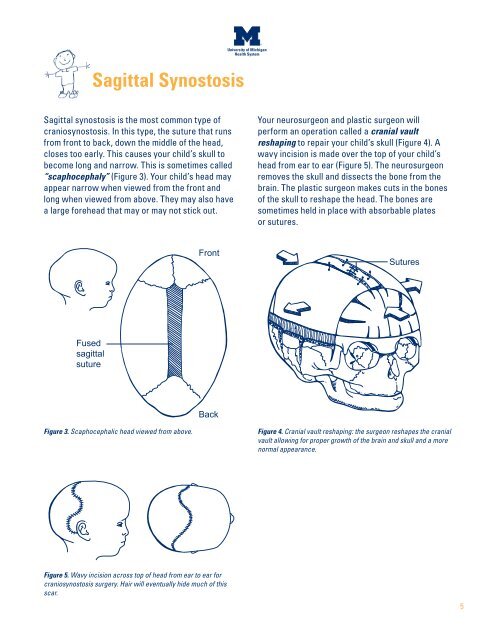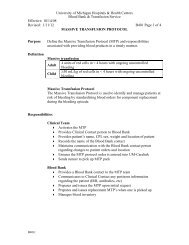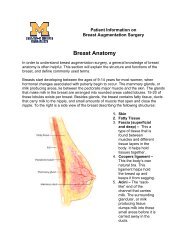Craniosynostosis & Craniofacial Surgery
Craniosynostosis & Craniofacial Surgery Parent's Guide
Craniosynostosis & Craniofacial Surgery Parent's Guide
- No tags were found...
You also want an ePaper? Increase the reach of your titles
YUMPU automatically turns print PDFs into web optimized ePapers that Google loves.
Sagittal Synostosis<br />
Sagittal synostosis is the most common type of<br />
craniosynostosis. In this type, the suture that runs<br />
from front to back, down the middle of the head,<br />
closes too early. This causes your child’s skull to<br />
become long and narrow. This is sometimes called<br />
“scaphocephaly” (Figure 3). Your child’s head may<br />
appear narrow when viewed from the front and<br />
long when viewed from above. They may also have<br />
a large forehead that may or may not stick out.<br />
Your neurosurgeon and plastic surgeon will<br />
perform an operation called a cranial vault<br />
reshaping to repair your child’s skull (Figure 4). A<br />
wavy incision is made over the top of your child’s<br />
head from ear to ear (Figure 5). The neurosurgeon<br />
removes the skull and dissects the bone from the<br />
brain. The plastic surgeon makes cuts in the bones<br />
of the skull to reshape the head. The bones are<br />
sometimes held in place with absorbable plates<br />
or sutures.<br />
Front<br />
Sutures<br />
Fused<br />
sagittal<br />
suture<br />
Back<br />
Figure 3. Scaphocephalic head viewed from above.<br />
Figure 4. Cranial vault reshaping: the surgeon reshapes the cranial<br />
vault allowing for proper growth of the brain and skull and a more<br />
normal appearance.<br />
Figure 5. Wavy incision across top of head from ear to ear for<br />
craniosynostosis surgery. Hair will eventually hide much of this<br />
scar.<br />
5









